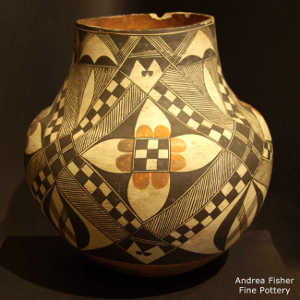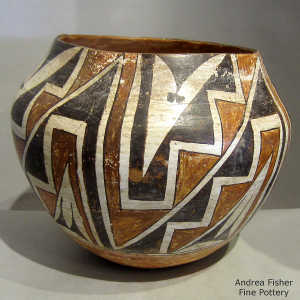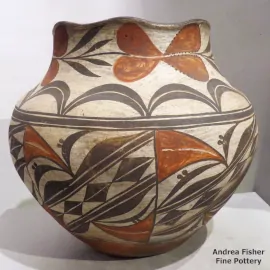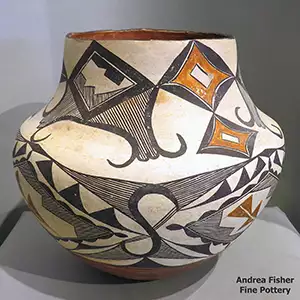Laguna Pueblo
- Kawaika'a: Lake People
- Language: Western Keres
- Size: 425,000 acres
- Population: 7,700
Pueblo History
A settlement was established at Laguna between 1697 and 1699 by refugees seeking to avoid conflict with the Spanish. Don Diego de Vargas and his Conquistadors arrived in northern New Mexico in 1692 (after the Spanish were expelled from northern New Mexico by the Pueblo Revolt of 1680). Along their way north they attacked and burned several pueblos. The survivors of those attacks scattered to places like Zuni, Hopi and Acoma, seeking refuge from the fighting.
The population pressure strained the resources of those pueblos and at Acoma, that forced the refugees to consider beginning their own settlement. That was the seed that began what many consider to be today's Laguna Pueblo. To ensure the survival of that seed, the organizers of that group made peace with the Spanish in the name of Laguna Pueblo in 1698. They dutifully began construction of the San Jose Mission church in 1699 and finished it in 1701.
That settlement at Laguna is dated to 1699 but archaeology and oral history indicate the area had already been occupied on and off for hundreds of years. When those refugees came down off the mesa at Acoma and moved to the landscape of Laguna, there were already several older pueblos in the area. Some of those families had been in the area since the days of the Mimbres and Jornada migrations. Others migrated in and out from the Jemez River Valley area and from the Pueblos of Zia and Santa Ana. Some had ancestors who'd migrated to the Hopi mesas and back. When they descended from Acoma to the village beside the lake they merged into a group of people from Zia, Santo Domingo, Cochiti and Santa Ana who'd moved to the area only a few years before.
"Laguna" is Spanish for "lake." The Lagunas name for themselves (Kawaika'a) transates roughly as "the people of the lake." A couple hundred years ago, to the southeast of Old Laguna there was a lake. The first Spanish explorers to reach Laguna (in 1540 and again in 1583) noted the presence of the lake. The lake is dry now but on what was the southwestern shore of the lake there is a 140-room ruin named Punyana that ceramic remains say was occupied between about 1300 and the mid-1400s CE. Then the people packed up and moved to the other side of the lake.
The Pueblo of Laguna commissioned geoarchaeological investigations to identify and date indigenous reservoirs on the pueblo's lands. One of the sites investigated was the ancient lake and its dam. They were able to ascertain dates for the deposition of sands in the lake bottom and in the gravel below it. Those dates indicate the dam was constructed after 1370 CE and before the mid-1700s. Their final conclusion was that the area was a wetland that the people of the time had made larger by building a rock and earth dam to hold more water. They also had an extensive canal and ditch system in place for irrigating their agricultural fields. That irrigation system extended for more than 60 miles through the Rio San Jose Basin, almost from today's Grants eastward to Mesita. Archaeological evidence in the Rio San Jose Basin indicates there was a distinct human presence before the 1300s. Some of the almost 1500 archaeological sites on pueblo land indicate humans were living there perhaps as long ago as 6500 BCE.
The first Spanish expedition to Tusayan found a pueblo on Antelope Mesa known as Kawaika'a. The folks who lived there spoke the parent dialect of Western Keres that the folks of Laguna and Acoma now speak a descendant of. Kawaika'a was just a few miles from Awatovi, a larger settlement on Antelope Mesa where most of the residents spoke either Towa or Keres.
Just beyond the southeastern corner of today's Laguna Reservation is what remains of Pottery Mound. Pottery Mound became famous when archaeologists discovered well-preserved wall murals in the buried kivas there. Pottery Mound is also the location of the largest and widest selection of prehistoric pot sherds and designs in all of New Mexico. Those pot sherds are why the village is named Pottery Mound. The beginning of the abandoment of Pottery Mound overlaps the beginning of the construction of Kawaika'a. That time period also coincides with the relocation of Sikyatki-style designs from Pottery Mound to the Hopi mesas.
Kawaika'a was abandoned late in the 1500s and many of the potters from there seem to have moved to Sikyátki, at the base of First Mesa. Sikyátki was the home of the Kokop clan (the Firewood clan) and the Coyote clan. Sikyatki also spoke mostly Towa and Keres. The quality of the pottery made at Sikyatki improved as the migrants from Kawaika'a got more involved in the process. But that didn't last long: Sikyatki was completely destroyed and almost everyone killed by warriors from Walpi and other Hopi villages in 1625. Those who were preserved from the carnage were ritual specialists from clans that were not represented in other Hopi pueblos, like the Kokop and the Coyote clans. Those specialists were transplanted to other Hopi pueblos (mostly to Walpi). But the production of Sikyátki-quality pottery was over. That pottery is what J. Walter Fewkes described as being the finest ceramics ever produced by the ancients.
Those families from Kawaika'a who'd relocated to Awatovi fared a bit better for a while but the Spanish impact grew significantly worse after 1629. The Pueblo Revolt in 1680 saw all the Spanish priests, acolytes and soldiers in Tusayan killed. San Bernard de Aguatubi mission was partially destroyed and the ruin converted to other uses. Spanish priests returned in 1698 and forced the reopening of the mission. Resistance from the Hopis grew until Awatovi itself was destroyed by warriors from Walpi, Oraibi and other villages in the winter of 1700-1701.
In 1701, back at Laguna, the new migrants were just putting the finishing touches on the new mission in the village that is now known as Old Laguna (that's the village we see now when we stop on the Interstate and take a look - if you want to drive through, follow US Highway 66, it goes right through the heart of the village).
Life at Laguna settled down and the people prospered as best they could under the Spanish and Franciscan yoke. The government changeover with the Mexican-American War didn't make much difference to the Lagunas. The quality and quantity of trade goods increased, then the missionaries arrived.
In the late 1860s the railroads were looking across New Mexico for a route to the West Coast. The best path they found was right across the middle of the Laguna Reservation. The tribe struck a deal and the railroad got started. It was about then that the Marmon brothers, devout Presbyterian missionaries and government surveyors, settled at Laguna and married well-connected Laguna women.
In 1872, Walter Marmon was elected Pueblo Governor and he saw an opportunity to change tribal laws: the cacique (religious leader of the village) died and he was able to block the appointment of a new one. That left the tribe without a spiritual head who could communicate with them in their own tongue.
Then Marmon had the two principal kivas of the tribe removed. That caused a schism where some traditionalist people left Old Laguna and established the pueblo at Mesita. Others left Laguna completely and headed for Sandia. However, they got held up at Isleta and were offered land there if their ritual specialists would guarantee their rituals would remain at Isleta. Of particular interest to the Isletans was the Katsina clan: Laguna clan members could perform masked dances and none of the Isletan clans could. Nor could any other clans in the Tiwa pueblos at Taos, Picuris and Sandia, so it was a matter of power and prestige. To this day there is a Laguna religious leader living at Isleta to guard and care for the Laguna clan's katsina masks. The Katsina clan was active again at Laguna by 1890 but the Puebloan religious hierarchy at Laguna was never reestablished. Presbyterian missionaries had replaced it with something alien to the tribe.
There was a falling out between the people of Isleta and the transplanted Lagunas. That caused many Lagunas to go back to Laguna while the others who stayed at Isleta established new villages on the northeast side of the Isleta Reservation. To make the pottery they were used to making, they went back to Laguna for clay and other materials. There seems to have been little cross-pollination between Isleta and Laguna potters (Southern Tiwa and Western Keres are not mutually intelligible languages).
In the 1890s, there were 19 clans at Laguna. 5 or 6 came from Acoma, 4 or 5 came from Zuni, 1 from San Felipe, 1 from Zia, 1 from Oraibi (Hopi), 2 from Sandia, 1 from Jemez, 1 from Shoshonean origins and 1 from unknown origins.
In 1900 the federal Bureau of Indian Affairs enacted a Religious Crimes Code that made it illegal for a Native American to participate in any ceremony that could be considered offensive to Christian standards. The Spanish did something like that, too, back in the days of the Inquisition when they were first invading the New World in search of converts with gold to steal... 300 years later there was no gold left but there were still souls to steal... (I don't have a problem with the churches, per se, my problem is with religious fundamentalists backed by legal subterfuge and heavily armed enforcers. This law was used for enforcing many things that the Christians of the time deemed to be their God-given duty, like forcing Native American children into Christian and government-run off-reservation boarding schools so they could be force fed the white man's religion and lose their roots in the world of their people. Now we're discovering cemeteries on the grounds of the old Indian Boarding Schools that hide the remains of hundreds of children stolen from their families and dying because they couldn't conform to the rules of an alien society.)
Today, Laguna Pueblo consists of Old/New Laguna (the main village) and the smaller villages of Paguate, Paraje, Encinal, Mesita and Seama. Each village still celebrates its own feast day and all villages celebrate September 19 as the Feast of St. Joseph.
Less than half the enrolled population of Laguna Pueblo actually lives and works on the pueblo as many members have been lured to Albuquerque for work.
Pottery History
Laguna's pottery tradition is very similar to that of Acoma. Shapes are very similar but designs are often more bold. The ancients also made more effigies, especially of bighorn rams. Before their travel was restricted by the Spanish, the ancient volcano we call "Mount Taylor" was part of their summer home and year-round hunting habitat. Bighorn sheep were common on the mountain. Effigies of the ram were also prayers for good hunting made manifest.
Arguments have been made that the "Tularosa spiral," of Jornada Mogollon heritage, might also represent the spirals of a large bighorn ram's horns. The name comes from designs on pot sherds found in the Tularosa Basin, east of the Rio Grande in New Mexico. The mountains around the Tularosa Basin were also flush with bighorn sheep in those days. Settlements attributed to the Jornada Mogollon people have been found in an area stretching from the Tularosa Basin west to near Springerville, AZ. Laguna is a bit north of the middle of that travel route.
Travel in those days was from watering hole to watering hole, and all villages were located close to a watering hole. Depending on the welcome they received, migrants might sometimes stop at a pueblo for a couple growing seasons. Some migrants never left while some groups picked up new migrants when they moved on. There was significant cultural and technological cross-pollination in the area of Laguna.
Like Acoma, Laguna was making lots of pottery until the 1920s. By 1930 pottery making had virtually stopped. Then Nancy Winslow, an Anglo woman from Albuquerque, taught two four-month arts and crafts sessions at the pueblo in 1973 and 1974.
The first class was composed of 22 pueblo members, among them Evelyn Cheromiah and her daughters. By the 1980s the Cheromiah's had become established potters and traditional Laguna pottery was well on its way to a comeback.







